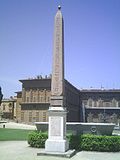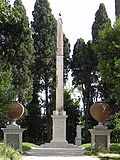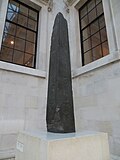| Name | Image | Height (with base) | Pharaoh | Original location | Current location | Ref |
|---|
| Name | Reign | Place (since) | City | Sovereign state |
|---|
| Unfinished obelisk |  | 41.75 m | Hatshepsut | 1479–1458 BC | Aswan (in situ) | Stone Quarries, Aswan | Aswan | Egypt | [7] |
| Lateran Obelisk |  | 32.18 m (45.70 m with base) | Thutmose III / Thutmose IV | 1479–1425 BC / 1401–1391 BC | Karnak | Lateran Palace | Rome | Italy | [1] |
| Karnak obelisks of Hatshepsut |  | 29.56 m | Hatshepsut | 1479–1458 BC | Karnak (in situ) | Karnak Temple | Luxor | Egypt | [1] |
Vatican obelisk
(a.k.a. St Peter's Square obelisk or Caligula's obelisk) |  | 25.5 m (41 m with base) | Unknown | Unknown | Alexandria | St. Peter's Square | Vatican City | Vatican City | [1] |
Luxor obelisks
(Luxor and Paris obelisks) |  | 25.03 m and 22.83 m | Ramesses II | 1279–1213 BC | Luxor Temple | Luxor Temple (in situ) | Luxor | Egypt | [1] |
 | Place de la Concorde (1833) | Paris | France | [1] |
Flaminio Obelisk
(a.k.a. Popolo obelisk) |  | 24 m (36.5 m with base) | Seti I / Ramesses II | 1294–1279 BC / 1279–1213 BC | Heliopolis | Piazza del Popolo | Rome | Italy | [1] |
Obelisk of Montecitorio
(a.k.a. Solare obelisk) |  | 21.79 m (33.97 m with base) | Psamtik II | 595–589 BC | Heliopolis | Piazza di Montecitorio | Rome | Italy | [1] |
| Karnak obelisk of Thutmosis I |  | 21.20 m | Thutmose I | 1506–1493 BC | Karnak (in situ) | Karnak | Luxor | Egypt | [1] |
Cleopatra's Needles
(London and New York obelisks) |  | 21.00 m | Thutmose III | 1479–1425 BC | Heliopolis (via Alexandria) | Victoria Embankment (1878) | London | United Kingdom | [2] |
 | Central Park (1881) | New York City | United States | [1] |
Al-Masalla obelisk
(a.k.a. Al Mataraiyyah obelisk) |  | 20.40 m | Senusret I | 1971–1926 BC | Heliopolis (in situ) | Al-Masalla area of Al-Matariyyah district in Heliopolis | Cairo | Egypt | [1] |
Obelisk of Theodosius
(a.k.a. Istanbul obelisk) |  | 18.54 m (25.6 m with base) | Thutmose III | 1479–1425 BC | Karnak | Sultanahmet Square | Istanbul | Turkey | [1] |
| Tahrir obelisk |  | 17 m | Ramesses II | 1279–1213 BC | Tanis | Tahrir Square (2020) | Cairo | Egypt | [10] [8] |
| Cairo Airport obelisk |  | 16.97 m | Ramesses II | 1279–1213 BC | Tanis | Cairo International Airport (1984) | Cairo | Egypt | [11] |
Pantheon obelisk
(a.k.a. Macuteo or Rotonda obelisk) |  | 14.52 m (26.34 m with base) | Ramesses II | 1279–1213 BC | Heliopolis | Piazza della Rotonda | Rome | Italy | [1] |
| Gezira obelisk |  | 13.5 m (20.4 m with base) | Ramesses II | 1279–1213 BC | Tanis | Gezira Island, Cairo | Cairo | Egypt | [12] |
Abgig obelisk
(a.k.a.Crocodilopolis obelisk) |  | 12.70 m | Senusret I | 1971–1926 BC | Faiyum (local area, found fallen) | Abgig | Faiyum | Egypt | [13] |
| Philae obelisk |  | 6.70 m | Ptolemy IX | 116–107 BC | Philae (Temple of Isis) | Kingston Lacy (1815) | Dorset | United Kingdom | [1] |
| Boboli Obelisk |  | 6.34 m | Ramesses II | 1279–1213 BC | Heliopolis (via Rome) | Boboli Gardens (1790) | Florence | Italy | [2] |
Elephant and Obelisk
(a.k.a. Minerveo obelisk) |  | 5.47 m (12.69 m with base) | Apries | 589–570 BC | Sais | Piazza della Minerva (Roman period, rediscovered 1665) | Rome | Italy | [1] |
| Abu Simbel obelisks |  | 3.13 m | Ramesses II | 1279–1213 BC | Abu Simbel (Great Temple) | Nubian Museum | Aswan | Egypt | [14] |
Urbino obelisk
(a.k.a. Albani obelisk) |  | 3.00 m | Apries | 589–570 BC | Sais (via Rome) | Ducal Palace | Urbino | Italy | [2] |
| Poznań obelisk |  | 3.00 m | Ramesses II | 1279–1213 BC | Athribis (via Berlin, 1895) | Poznań Archaeological Museum (2002) | Poznań | Poland | [15] [16] [17] |
Matteiano obelisk
(a.k.a. Celimontana obelisk) |  | 2.68 m (12.23 m with base) | Ramesses II | 1279–1213 BC | Heliopolis | Villa Celimontana | Rome | Italy | [1] |
Durham obelisk
(a.k.a. Alnwick or Algernon obelisk) |  | 2.15 m | Amenhotep II | 1427–1401 BC | unknown (within the Thebaid) | Oriental Museum, University of Durham (1838) | Durham | United Kingdom | [1] |
Dogali obelisk
(a.k.a. Casanatese obelisk) |  | 2 m (6.34 m with base) | Ramesses II | 1279–1213 BC | Heliopolis | Baths of Diocletian | Rome | Italy | [19] [20] |
| Abishemu obelisk |  | 1.25 m (1.45 m with base) | Abishemu (King of Byblos) | 1800s BC | Temple of the Obelisks | Beirut National Museum | Beirut | Lebanon | [21] |
| Karnak obelisk of Seti II |  | 0.95 m | Seti II | 1203–1197 BC | Karnak (in situ) | Karnak | Luxor | Egypt | [22] |
| Luxor obelisk |  | 0.95 m (original est. 3 m) | Ramesses III | 1186–1155 BC | Karnak | Luxor Museum (1923) | Luxor | Egypt | [23] |
| Obelisks of Nectanebo II |  | 0.95 m (original est. 5.5 m) | Nectanebo II | 360–342 BC | Hermopolis | British Museum | London | United Kingdom | [1] |
































